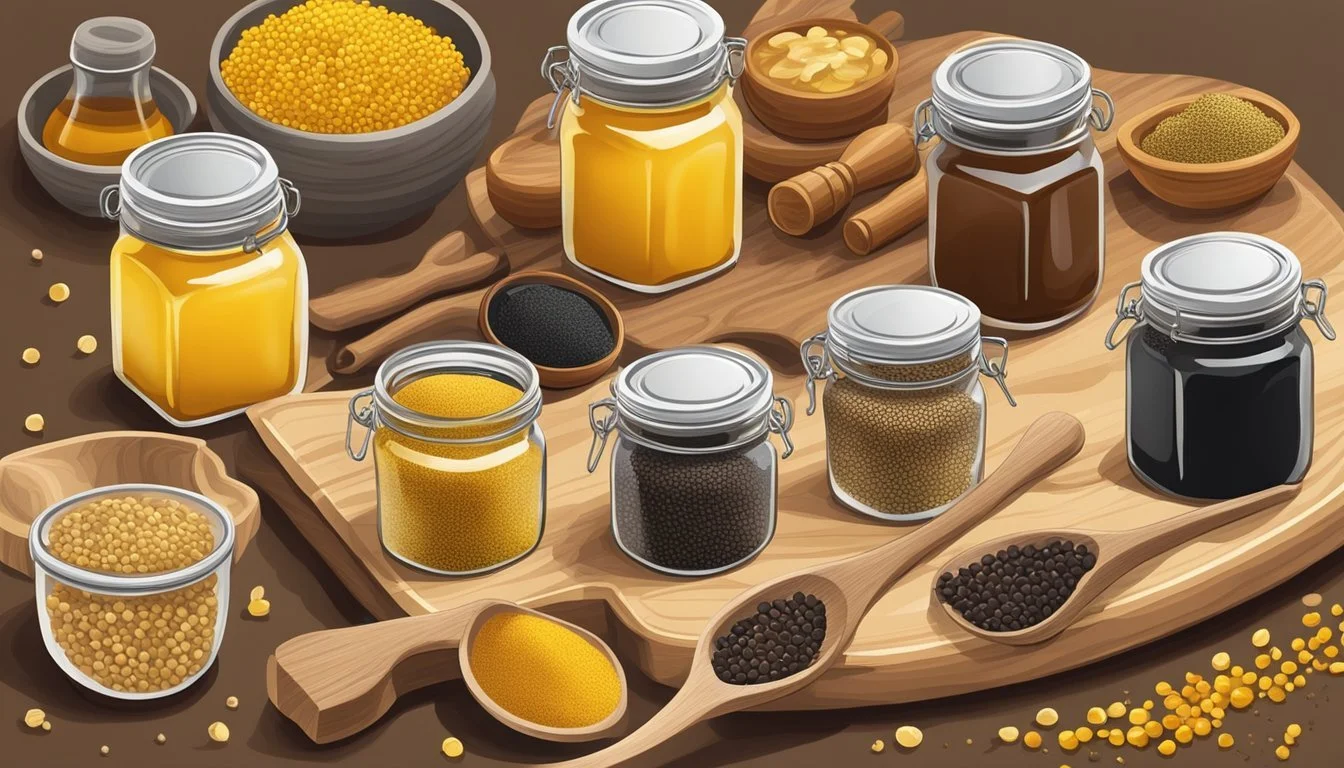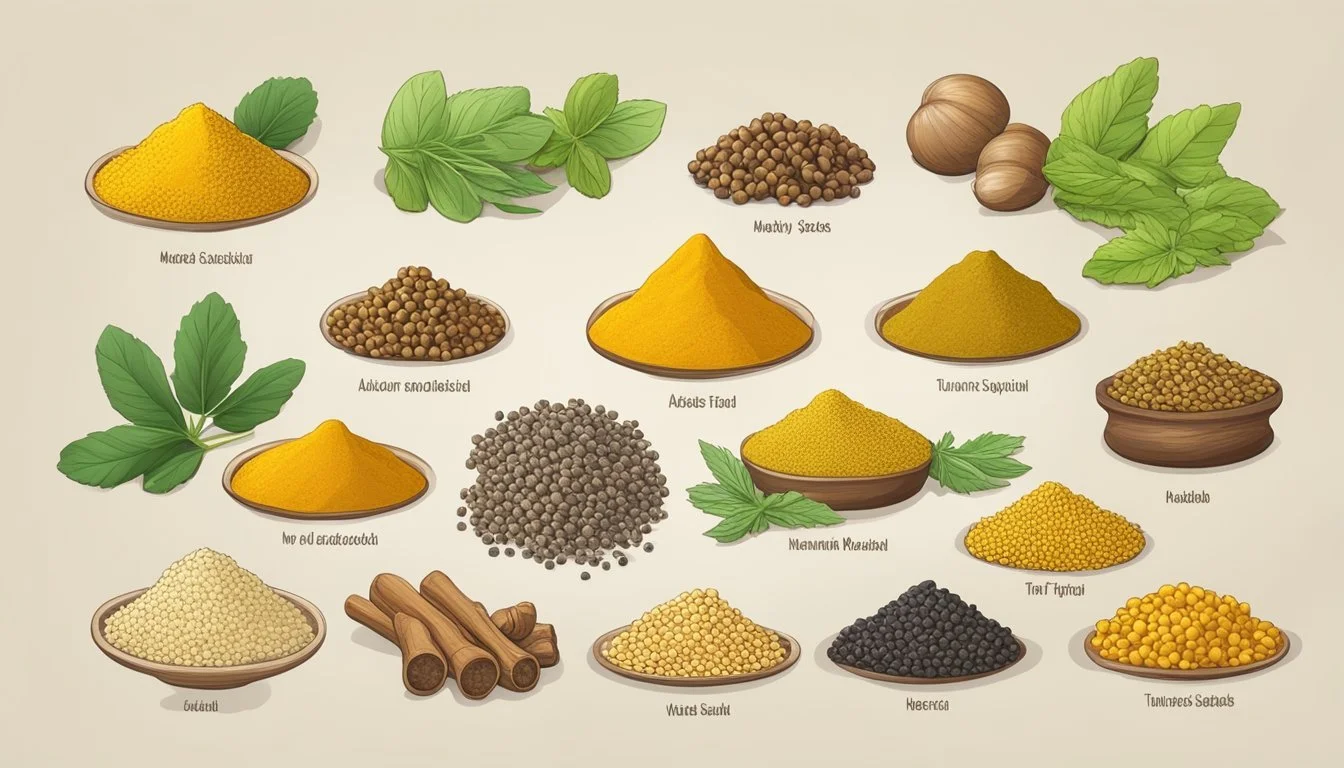Mustard Substitutes
Top Alternatives for Every Dish
Finding the right mustard substitute can elevate your dish without compromising flavor or texture. Whether you're out of mustard or catering to specific dietary needs, there are numerous effective alternatives that can replicate the tangy, spicy notes of mustard.
For those looking to replace yellow mustard, mayonnaise can be an excellent choice; it maintains the same consistency, even though it provides a milder flavor profile. Alternatively, white vinegar offers the acidic punch required in recipes where mustard's vinegary edge is essential, but should be used sparingly due to its potency.
When substituting Dijon mustard, stone-ground mustard stands out as the best option. It shares the same brown mustard seeds, giving it a robust flavor that closely matches Dijon. If you seek a spicier bite, wasabi or horseradish mixed with yellow mustard can effectively mimic the desired heat and tanginess.
Understanding Mustard and Its Characteristic Flavors
Mustard is a versatile ingredient with a unique blend of flavors, from tangy to spicy, that enhances various culinary creations. Below is an exploration of mustard's basic components and its wide-ranging culinary applications.
The Basics of Mustard
Mustard is made from the seeds of the mustard plant. There are several types of mustard seeds including yellow, brown, and black, each bringing different flavor intensities. Yellow mustard seeds are milder and are often used to make the classic American yellow mustard.
Dijon mustard, typically made from brown or black seeds, offers a stronger, spicier taste. Mustard seeds are often mixed with vinegar, water, and various spices to create different prepared mustard varieties.
The result is a condiment that can range from smooth to coarse and from mildly tangy to sharply pungent, depending on the ingredients and preparation method.
Culinary Uses of Mustard
Mustard serves as a key condiment in many cuisines. It is frequently used in sandwiches, salad dressings, and marinades. Yellow mustard, with its mild tangy flavor, is a staple in American cuisine, perfect for burgers and hot dogs.
Dijon mustard, with its more complex and intense flavor, is favored in French dishes and gourmet cooking. It enhances sauces, glazes, and even vinaigrettes, offering a sophisticated depth to dishes.
Mustard also acts as an emulsifier in dressings and sauces, helping to bind oil and vinegar together. Its robust flavor pairs well with meats, cheeses, and vegetables, making it a flexible and indispensable ingredient.
Common Mustard Substitutes
When mustard is unavailable or unsuitable, there are several alternatives that can offer similar flavors and textures. Each substitute serves a unique purpose, providing a range of taste and heat levels.
Horseradish as a Substitute
Horseradish, a root vegetable known for its pungent heat, can be a strong stand-in for mustard. When using prepared horseradish, it provides a similar spicy kick, making it suitable for sauces, dressings, and marinades. Fresh horseradish can be grated and added to recipes in smaller quantities to achieve the desired heat. It pairs well with meats and seafood, adding depth without overwhelming other flavors.
Note: Start with a small amount and adjust to taste to avoid overpowering the dish.
Wasabi: A Spicy Alternative
Wasabi, often associated with Japanese cuisine, offers an intense heat that can rival mustard. Typically available as a paste or powder, wasabi can be mixed with water to create a substitute for mustard in dips and dressings. It has a sharp, clean flavor that brightens up meats and vegetables.
Bear in mind, authentic wasabi can be rare and costly, with many products on the market being a blend of horseradish, mustard, and food coloring.
Turmeric for Color and Mild Heat
Turmeric, a vibrant yellow spice, can be used when mustard's color and mild heat are desired. Its earthy, slightly bitter flavor makes it a good addition to soups, stews, and rice dishes. While it won't replicate mustard's tang, it brings a warmth and depth of flavor.
Consider combining turmeric with vinegar or lemon juice to mimic mustard's acidity. This blend works well in salad dressings or marinades.
Mayonnaise and Other Creamy Options
Mayonnaise can be a versatile substitute for mustard, especially in sandwiches and dressings where a creamy texture is desired. Plain mayonnaise offers a mild flavor, but adding spices or a touch of vinegar can enhance it further.
Other creamy options include Greek yogurt or sour cream, which can be mixed with spices like garlic powder, paprika, or turmeric for added zest. These alternatives work particularly well in coleslaw, potato salad, and deviled eggs.
Creating Mustard Substitutes at Home
Making your own mustard substitute can be a simple and satisfying task. By using pantry staples like mustard seeds, vinegar, and honey, you can create variations that suit your culinary needs.
Make Your Own Mustard Mix
To make your own mustard mix, start by using mustard seeds, which come in yellow, brown, and black varieties. Yellow mustard seeds are the mildest, while black seeds are the spiciest.
Grind the seeds
Use a spice grinder to finely grind the mustard seeds.Add liquids
Combine the ground seeds with water, vinegar, and a bit of sugar for sweetness.Adjust to taste
Adjust the proportions to match desired spiciness and tanginess.
This homemade mix can substitute dry mustard in recipes, such as marinades and dressings.
Crafting Homemade Mustard Sauce
Crafting a homemade mustard sauce involves blending a few simple ingredients. Begin with prepared mustard or ground mustard as the base.
Combine base ingredients
Mix ground mustard with water until it reaches a paste-like consistency.Add flavor enhancers
Incorporate vinegar, oils, honey, and ginger for a balanced flavor profile.Adjust consistency
If a thinner sauce is preferred, adjust with more water or oil.
This homemade mustard sauce works wonderfully in salad dressings and vinaigrettes, offering a personalized touch to your dishes.
Alternatives for Specific Mustard Types
Different types of mustard each have unique flavors and uses in recipes, leading to a demand for specific substitutes when they're unavailable. This section addresses alternatives for yellow mustard, Dijon mustard, spicy brown mustard, and honey mustard with practical suggestions and details.
Replicates for Yellow Mustard
Yellow mustard is a staple in many kitchens due to its mild flavor and tangy taste. If unavailable, several alternatives can be used:
Turmeric offers similar color without much flavor impact.
Prepared mustard or stone-ground mustard works well, providing a comparable taste.
For a tangier profile, white vinegar can be used, but it is more potent, so it's important to start with small amounts.
Mayonnaise can replace mustard in sandwiches and dressings, although it lacks the tanginess.
Dijon Mustard Substitutes
Dijon mustard is known for its smooth texture and sophisticated flavor.
Stone-ground mustard is the best 1:1 substitute, providing a similar but slightly earthier taste.
Yellow mustard can be used in recipes needing a milder alternative with a bit less complexity.
For a homemade version, mixing mustard powder with water, salt, and a touch of vinegar can mimic Dijon.
Mayonnaise can serve as a base, adding mustard powder for a creamy yet sharp substitute.
Options for Spicy Brown Mustard
Spicy brown mustard offers a robust and bold flavor.
Horseradish can be used for its spicy kick, providing a similar heat level. It's best in small quantities, blended with mayonnaise or another mild condiment.
Yellow mustard or stone-ground mustard also works, though they are less spicy, so additional seasonings like chili flakes might be necessary.
Prepared mustard with added spices or hot sauces can recreate the heat and flavor profile.
Honey Mustard Alternatives
Honey mustard combines sweetness and tanginess, often used in dressings and dips.
Creating a simple mix of honey and yellow mustard in a 2:1 ratio can replicate this flavor.
Maple syrup or agave nectar combined with yellow mustard also works for a different but still sweet profile.
Mayonnaise mixed with honey offers a creamier alternative.
For a spicier kick, adding a bit of stone-ground mustard to the mixture can enhance the depth of flavor.
Considerations for Choosing a Mustard Substitute
Choosing the right mustard substitute involves evaluating factors like allergies, dietary restrictions, and the desired flavor profile. It's important to consider these elements to ensure the best fit for the recipe and personal preferences.
Allergies and Dietary Restrictions
Individuals with mustard allergies need to find substitutes that eliminate mustard entirely from their diets. Horseradish, for instance, can provide a similar spiciness without the mustard allergens. Tahini and hummus also offer creamy, tangy alternatives that are safe for people with this allergy.
For those following vegan diets, substitutes like nutritional yeast can emulate mustard's tanginess and depth. Vinegar-based alternatives, such as apple cider vinegar mixed with spices, are also suitable. Prepared plant-based mustards can be another excellent option, provided they don't include allergens.
In summary, finding the right substitute requires careful consideration of ingredient labels and potential cross-contaminants.
Flavor Profiles and Intensity
The flavor profile and intensity of the substitute play a significant role in achieving the desired taste in recipes. Mustard varies from mild yellow to intense black seed varieties. Substitutes should match this range.
Yellow mustard can be replaced with turmeric or white vinegar for a similar mild tanginess. For more intense mustard flavors, wasabi or horseradish work well, offering a sharp, spicy kick. Brown mustard seeds can be swapped with spicy mustard varieties or chipotle peppers for similar intensity.
Matching the spiciness and tanginess is key. Curry powder can also mimic the complex flavors of mustard, adding both heat and depth to dishes.
Integration of Mustard Substitutes in Diverse Dishes
Exploring mustard substitutes can elevate the flavor complexity in various dishes. Each substitute offers unique attributes that make them suitable for specific culinary applications, such as meat preparations, salad dressings, soups, and sauces.
Application in Meat Preparations
Using mustard substitutes in meat preparations can provide intriguing flavors and textures. For marinades and glazes, white vinegar or apple cider vinegar adds sharp acidity without overwhelming the dish. Combining honey and yellow mustard makes a great glaze for pork or chicken.
Wasabi and prepared horseradish bring a bold, spicy punch, ideal for beef dishes. They can be blended with other seasonings for a robust marinade. Worcestershire sauce works well as a flavorful base, enhancing barbecued or grilled meats. Integrating these substitutes ensures meats are both tender and flavorful.
Using Substitutes in Salad Dressings and Vinaigrettes
In salad dressings and vinaigrettes, mustard substitutes can change both flavor and consistency. Dijon mustard can be replaced with a small amount of wasabi or prepared horseradish for a spicy kick. White vinegar or apple cider vinegar can substitute for the acidity typically provided by mustard.
For those looking to create a creamy dressing, mayonnaise serves as a mild, thick alternative. Mixing honey with vinegar or lemon juice creates a sweet and tangy vinaigrette. These substitutes allow for customizing each dressing to suit specific tastes and dietary needs.
Enhancing Soups and Stews with Alternatives
Mustard substitutes can enhance the depth of flavor in soups and stews. White vinegar or apple cider vinegar can replace mustard to add bright acidity. Hoisin sauce and Worcestershire sauce introduce complex, savory notes, perfect for hearty stews.
Adding a small amount of prepared horseradish to soups lends spiciness and heat, while a touch of honey mustard can balance savory broths with slight sweetness. By integrating these substitutes thoughtfully, a simple soup or stew transforms into a rich, flavorful meal.
Creative Use in Sauces and Condiments
Creative use of mustard substitutes in sauces and condiments can significantly alter and enhance the experience of a meal. Barbecue sauce can benefit from the addition of apple cider vinegar for a tangy twist. Mayonnaise serves as a good base for homemade spreads or dipping sauces, offering a creamy texture.
Ketchup mixed with prepared horseradish creates a zesty condiment perfect for burgers or sandwiches. Hoisin sauce and Worcestershire sauce can add depth and umami to various sauces, bringing unique flavor profiles to everyday meals. By experimenting with these alternatives, one can craft distinctive and memorable sauces and condiments.
Nutrition and Health Aspects of Mustard and Its Substitutes
Mustard and its substitutes vary in their nutritional profiles. This section explores the differences in calories, fat, and protein content to provide a clear comparison.
Caloric and Macronutrient Comparisons
Prepared Mustard: Mustard is a low-calorie condiment. A tablespoon typically contains around 3-5 calories, with minimal fat (0.2g) and protein (0.3g). Mustard is also rich in essential minerals like iron and calcium.
Wasabi: Another substitute, wasabi, is low in calories, offering about 10 calories per tablespoon. It contains negligible fat and protein, making it suitable for those watching their calorie intake.
Mayonnaise: Mayonnaise, often used as a mustard substitute, is higher in calories. A tablespoon contains approximately 94 calories, 10g of fat, and 0.1g of protein. While it offers a creamy texture, its high-fat content is significant.
Cottage Cheese: Cottage cheese can be an alternative, especially in creamy recipes. A tablespoon has about 4-5 calories, 0.5g of fat, and 0.6g of protein, making it a nutritious choice.
White Vinegar: White vinegar is another option, with virtually zero calories, fat, and protein per tablespoon. It provides the acidity and tang characteristic of mustard without adding caloric value.
Each substitute presents unique nutritional benefits. Preferences will depend on dietary needs and health goals.







